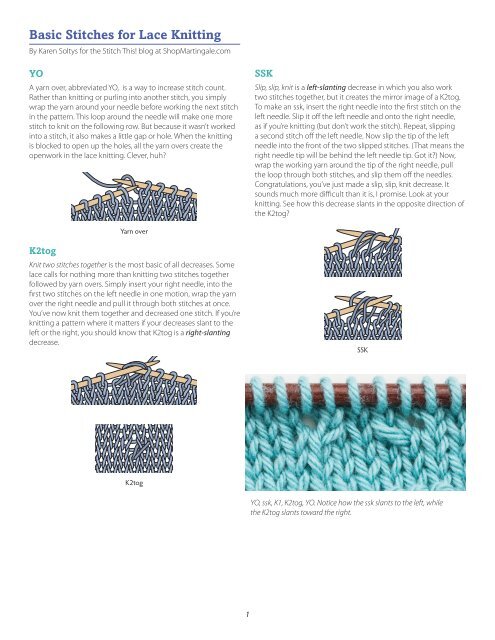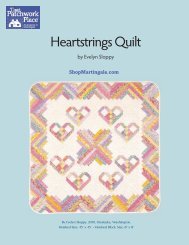Basic Stitches for Lace Knitting - Stitch This! The Martingale Blog ...
Basic Stitches for Lace Knitting - Stitch This! The Martingale Blog ...
Basic Stitches for Lace Knitting - Stitch This! The Martingale Blog ...
Create successful ePaper yourself
Turn your PDF publications into a flip-book with our unique Google optimized e-Paper software.
<strong>Basic</strong> <strong><strong>Stitch</strong>es</strong> <strong>for</strong> <strong>Lace</strong> <strong>Knitting</strong><br />
By Karen Soltys <strong>for</strong> the <strong>Stitch</strong> <strong>This</strong>! blog at Shop<strong>Martingale</strong>.com<br />
YO<br />
A yarn over, abbreviated YO, is a way to increase stitch count.<br />
Rather than knitting or purling into another stitch, you simply<br />
wrap the yarn around your needle be<strong>for</strong>e working the next stitch<br />
in the pattern. <strong>This</strong> loop around the needle will make one more<br />
stitch to knit on the following row. But because it wasn’t worked<br />
into a stitch, it also makes a little gap or hole. When the knitting<br />
is blocked to open up the holes, all the yarn overs create the<br />
openwork in the lace knitting. Clever, huh?<br />
SSK<br />
Slip, slip, knit is a left-slanting decrease in which you also work<br />
two stitches together, but it creates the mirror image of a K2tog.<br />
To make an ssk, insert the right needle into the first stitch on the<br />
left needle. Slip it off the left needle and onto the right needle,<br />
as if you’re knitting (but don’t work the stitch). Repeat, slipping<br />
a second stitch off the left needle. Now slip the tip of the left<br />
needle into the front of the two slipped stitches. (That means the<br />
right needle tip will be behind the left needle tip. Got it?) Now,<br />
wrap the working yarn around the tip of the right needle, pull<br />
the loop through both stitches, and slip them off the needles.<br />
Congratulations, you’ve just made a slip, slip, knit decrease. It<br />
sounds much more difficult than it is, I promise. Look at your<br />
knitting. See how this decrease slants in the opposite direction of<br />
the K2tog?<br />
Yarn over<br />
K2tog<br />
Knit two stitches together is the most basic of all decreases. Some<br />
lace calls <strong>for</strong> nothing more than knitting two stitches together<br />
followed by yarn overs. Simply insert your right needle, into the<br />
first two stitches on the left needle in one motion, wrap the yarn<br />
over the right needle and pull it through both stitches at once.<br />
You’ve now knit them together and decreased one stitch. If you’re<br />
knitting a pattern where it matters if your decreases slant to the<br />
left or the right, you should know that K2tog is a right-slanting<br />
decrease.<br />
SSK<br />
K2tog<br />
YO, ssk, K1, K2tog, YO. Notice how the ssk slants to the left, while<br />
the K2tog slants toward the right.<br />
1
SKP<br />
SKP stands <strong>for</strong> slip one stitch, knit one stitch, pass the slipped stitch<br />
over. You might also see this decrease abbreviated as PSSO, or<br />
“pass slipped stitch over.” Whichever way the instructions list it,<br />
here’s what you do: Slip one stitch from the left needle onto the<br />
right needle; knit the next stitch on the left needle. Now use the<br />
tip of the left needle to lift the slipped stitch (the second stitch in<br />
on the right needle) up and over the stitch you just knit. Drop the<br />
slipped stitch off the needle completely. Mission accomplished.<br />
K2tog-tbl<br />
Knit two stitches together through the back loop. Just when you<br />
thought there couldn’t be one more way to make a left-slanting<br />
decrease, here’s one more. <strong>This</strong> happens to be my personal<br />
favorite, as it really does make the exact opposite of K2tog. And,<br />
it takes fewer motions to do this decrease than the variations<br />
where you’re slipping stitches and passing the slipped stitches<br />
over other stitches. I learned this from Donna Druchunas, who<br />
shared it in Successful <strong>Lace</strong> <strong>Knitting</strong>. I’ve used it ever since.<br />
For this left-slanting decrease, insert your right needle into the<br />
back of the first two stitches on the left needle. Wrap the yarn<br />
around the needle as if to knit, pull the loop through both<br />
stitches, and slip those stitches off the left needle. Easy peasy.<br />
My new favorite decrease!<br />
SKP<br />
K2tog-tbl<br />
SKP<br />
K2tog-tbl<br />
2 <strong>Basic</strong> <strong><strong>Stitch</strong>es</strong> <strong>for</strong> <strong>Lace</strong> <strong>Knitting</strong>
DCD<br />
A DCD is knitting shorthand <strong>for</strong> double center decrease. Wait, what?<br />
Remember, lace knitting is made of yarn overs (increases) and<br />
corresponding decreases. Usually they’re made in pairs so that the<br />
stitch count remains constant. But sometimes, you want a decrease<br />
in the center of a lace panel or project with a yarn-over hole on<br />
either side. To keep the stitch count even, you need to do a double<br />
decrease in the center to account <strong>for</strong> the two yarn overs. <strong>This</strong><br />
involves decreasing three stitches down to one stitch. Here’s how to<br />
do that. It’s pretty much like doing the SKP.<br />
An alternate method <strong>for</strong> a DCD is to:<br />
1. Slip two stitches from the left needle onto the right<br />
needle.<br />
2. Knit one stitch.<br />
3. Pass both slipped stitches over the knitted stitch and off<br />
the needles. Two stitches decreased.<br />
1. Slip one stitch from the left needle onto the right needle.<br />
2. Knit the next two stitches together. (K2tog = one stitch<br />
decreased.)<br />
3. Lift the slipped stitch over the K2tog stitch and off the needles.<br />
(A second stitch decreased.)<br />
I told you it would be easy. But just to make things a bit more<br />
confusing, you may also see this abbreviated as SK2P, short <strong>for</strong> slip<br />
one stitch, K2tog, pass slipped stitch over. Got it? I knew you would!<br />
Slip two stitches together<br />
as if to knit. Knit the next<br />
stitch on the left needle.<br />
Pass the two slipped<br />
stitches over the knit<br />
stitch on the right needle.<br />
DCD<br />
Sl 2, K1, psso<br />
DCD<br />
Sl1, K2tog, psso<br />
Well, there you have it. <strong>The</strong> essential stitches you need to know<br />
<strong>for</strong> lace knitting.<br />
© 2012 <strong>Martingale</strong><br />
DCD. Notice how 3 stitches are decreased down to 1 stitch,<br />
and flanked by YOs.<br />
19021 120th Ave. NE, Ste. 102<br />
Bothell, WA 98011 USA<br />
800.426.3126<br />
www.Shop<strong>Martingale</strong>.com<br />
3 <strong>Basic</strong> <strong><strong>Stitch</strong>es</strong> <strong>for</strong> <strong>Lace</strong> <strong>Knitting</strong>






